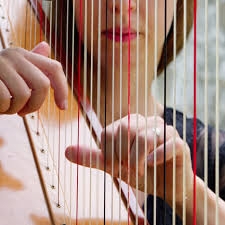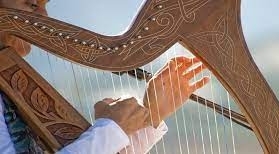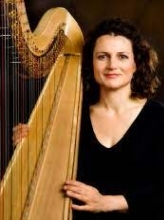  The harp is a large stringed musical instrument. Various kinds of harps are found in Europe, Africa, Asia, and North and South America.
Harps have individual strings running at an angle to a soundboard; the strings are plucked with the fingers. Its most common form is triangular in shape and made of wood. Some have multiple rows of strings, and pedal attachments.
The harp is a large stringed musical instrument. Various kinds of harps are found in Europe, Africa, Asia, and North and South America.
Harps have individual strings running at an angle to a soundboard; the strings are plucked with the fingers. Its most common form is triangular in shape and made of wood. Some have multiple rows of strings, and pedal attachments. Ancient depictions of harps, dating back at least as early as 3000 BC, were recorded in Mesopotamia, Persia and Egypt, and later in India and China. By medieval times, harps had spread across Europe. Harps were found across the Americas, where the harp was a popular folk tradition in some areas. Distinct designs also emerged from the African continent. The Concert harp, or Pedal harp, is a large and technologically modern harp, designed primarily for use in concert music. It can be played solo as part of a chamber ensemble, or in an orchestra. It typically has 47 strings with seven strings per octave, giving a range of six and a half octaves. In this type of harp the pedals alter the pitch of the strings, so that the pedal harp can easily play works written in any key. A pedal harp typically stands about 1.8 m high, is 1.2 m deep, and 55 cm wide at the bass end of the soundboard. It weighs about 36 kg. The body consists of a straight upright pillar, sometimes adorned with a crown at the top, and a soundboard, which in most harps is pear-shaped with additional width at the bottom. There is also a curved neck containing the mechanical action made up of over 1,400 parts, and a base with seven pedals.  The D, E, G, A, and B strings are normally colored white, while the C strings are colored red and the F strings either black or blue. The lowest strings are made of copper or steel-wound nylon, the middle-lower of catgut, and the middle to highest of nylon, although more or all of the strings may be gut. The total tension of the strings on the soundboard is roughly 1000 kg.
The D, E, G, A, and B strings are normally colored white, while the C strings are colored red and the F strings either black or blue. The lowest strings are made of copper or steel-wound nylon, the middle-lower of catgut, and the middle to highest of nylon, although more or all of the strings may be gut. The total tension of the strings on the soundboard is roughly 1000 kg.
The pedal harp is played with the fingertips of the first four fingers. The little fingers aren't used because they're too short and can't reach the correct position without distorting the position of the other fingers. Plucking with varying degrees of force creates dynamics (loudness and softness).  Different types of plucking can also create different tones and sounds. Depending on the finger position, different tones can be produced: a full sound in the middle of the string, and a nasal, guitar-like sound at the very bottom.
Different types of plucking can also create different tones and sounds. Depending on the finger position, different tones can be produced: a full sound in the middle of the string, and a nasal, guitar-like sound at the very bottom.Tone is also affected by the skin of the harpist, how much oil and moisture it contains, and the amount of thickening by callus formation and its surface texture.  The modern concert harp is a technologically advanced instrument, distinguished by its use of 'pedals' which can alter the pitch of given strings. The pedal harp contains seven pedals that each affect the tuning of all strings of one pitch-class. The pedals, from left to right, are D, C, B on the left side and E, F, G, A on the right. The addition of pedals increased the harp's abilities, allowing its entry into the classical orchestra beginning in the 19th century. The harp had played little or no role in early classical music, being used only a few times by major composers such as Mozart and Beethoven.
The modern concert harp is a technologically advanced instrument, distinguished by its use of 'pedals' which can alter the pitch of given strings. The pedal harp contains seven pedals that each affect the tuning of all strings of one pitch-class. The pedals, from left to right, are D, C, B on the left side and E, F, G, A on the right. The addition of pedals increased the harp's abilities, allowing its entry into the classical orchestra beginning in the 19th century. The harp had played little or no role in early classical music, being used only a few times by major composers such as Mozart and Beethoven.
How much do harps cost? Here are some recent (2023) prices in US dollars:
A Few Famous Harpists  King David
King DavidKing David’s harp is the most iconic and well-known harp in the history of the Christian world. Born in Bethlehem and a key figure in biblical history, King David was King of Israel from 101-970 BC. Documentation from the Old Testament book of Samuel proclaims King David’s proficiency as a harpist. Not only would he play the harp to soothe and entertain his predecessor, King Saul, but he also composed psalms and designed the classical design of harps still used today. He played a type of harp known as the Kinnor harp, and images of King David and his harp have been painted throughout history.  Alice Giles
Alice GilesAlice Giles may be one of the most influential harpists in history. Known for her evocative interpretations, she has captivated audiences worldwide with her performances. An educator as well, Giles has inspired generations of young harpists. The Australian-born musician first attracted international notice when she won First in the Israel International Harp Contest at the age of 21. Since then she has performed extensively internationally both in recital and with orchestras. Visit her website at https://www.alicegiles.com/, and see her music videos.  Jana Boušková
Jana BouškováFrom the Czech Republic, Jana Boušková has gained international recognition for her extraordinary technical prowess and profound musicianship. Known for her captivating stage presence and rich, expressive interpretations, she has garnered numerous prestigious awards throughout her career. Highly respected within the harp community, her exceptional talent and dedication to her craft have secured her a place amongst the top harp musicians. Visit her website at https://www.janabouskova.com/, and see her music videos. |